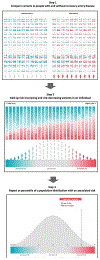Clinical applications of polygenic risk score for coronary artery disease through the life course
- PMID: 37931336
- PMCID: PMC10842813
- DOI: 10.1016/j.atherosclerosis.2023.117356
Clinical applications of polygenic risk score for coronary artery disease through the life course
Abstract
Coronary artery disease (CAD) remains a leading cause of morbidity and mortality worldwide, highlighting the limitations of current primary and secondary prevention frameworks. In this review, we detail how the polygenic risk score for CAD can improve our current preventive and treatment frameworks across three clinical applications that span the life course: (i) identification and treatment of people at increased risk early in the life course prior to the onset of clinical risk factors, (ii) improving the precision around risk estimation in middle age, and (ii) guiding treatment decisions and enabling more efficient clinical trials even after the onset of CAD. We end by summarizing the efforts needed as we head towards more widespread use of polygenic risk score for CAD in clinical practice.
Keywords: Cardiovascular prevention; Coronary artery disease; Genetics; Genomic medicine; Genomic risk prediction; Polygenic score.
Copyright © 2023 Elsevier B.V. All rights reserved.
Conflict of interest statement
Declaration of competing interest The authors declare the following financial interests/personal relationships which may be considered as potential competing interests: A.C.F. is a co-founder of Goodpath and reports a grant from Abbott Vascular, both unrelated to the present work. P.N. reports investigator-initiated grants from Allelica, Amgen, Apple, AstraZeneca, Boston Scientific, and Novartis, personal fees from Allelica, Apple, AstraZeneca, Blackstone Life Sciences, Foresite Labs, GV, HeartFlow, Novartis, Roche / Genentech, is a co-founder of TenSixteen Bio, is a scientific advisory board member of Esperion Therapeutics, Preciseli, and TenSixteen Bio, and spousal employment at Vertex Pharmaceuticals, all unrelated to the present work.
Figures


References
-
- Tsao CW, Aday AW, Almarzooq ZI, Anderson CAM, Arora P, Avery CL, Baker-Smith CM, Beaton AZ, Boehme AK, Buxton AE, Commodore-Mensah Y, Elkind MSV, Evenson KR, Eze-Nliam C, Fugar S, Generoso G, Heard DG, Hiremath S, Ho JE, Kalani R, Kazi DS, Ko D, Levine DA, Liu J, Ma J, Magnani JW, Michos ED, Mussolino ME, Navaneethan SD, Parikh NI, Poudel R, Rezk-Hanna M, Roth GA, Shah NS, St-Onge M-P, Thacker EL, Virani SS, Voeks JH, Wang N-Y, Wong ND, Wong SS, Yaffe K, Martin SS, on behalf of the American Heart Association Council on Epidemiology and Prevention Statistics Committee and Stroke Statistics Subcommittee, Heart Disease and Stroke Statistics—2023 Update: A Report From the American Heart Association, Circulation. 147 (2023)e93–e621. 10.1161/CIR.0000000000001123. - DOI - PubMed
Publication types
MeSH terms
Grants and funding
LinkOut - more resources
Full Text Sources
Medical
Miscellaneous

